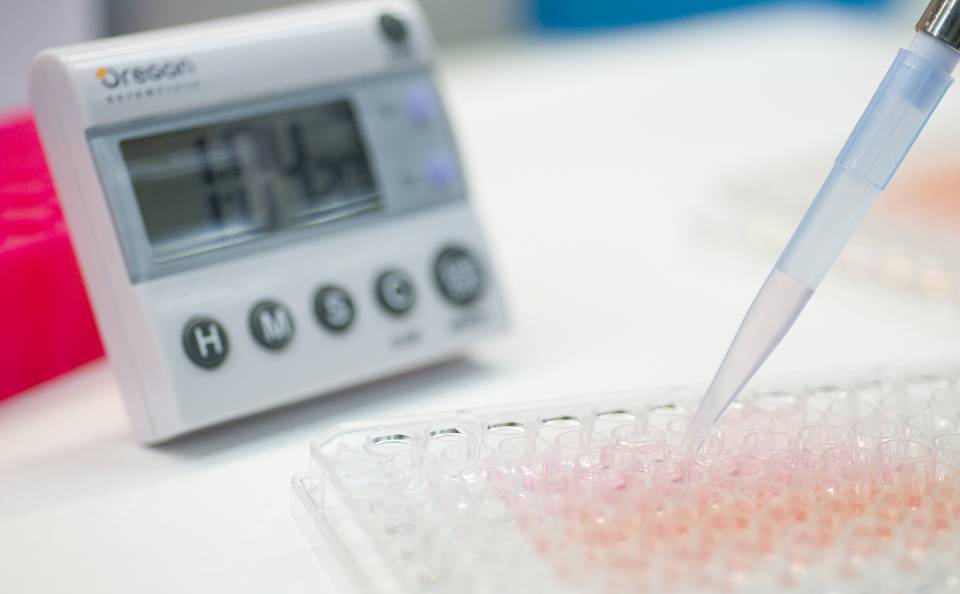Through a routine blood test, a protein, phosphorylated tau protein, can help diagnose the disease, even in people with very early symptoms.
The study was coordinated by Mircea Balasa, a neurologist from the Alzheimer’s Disease and Other Cognitive Disorders Unit and researcher in the IDIBAPS Alzheimer’s Disease and Other Cognitive Disorders research group; Raquel Sánchez-Valle, head of the Hospital Clínic Neurology Service and the Alzheimer’s Disease and Other Cognitive Disorders Unit and leader of the IDIBAPS research group; and Albert Lladó, neurologist in the Alzheimer’s Disease and Other Cognitive Disorders Unit and IDIBAPS researcher. The first author of the study is Jordi Sarto, neurologist and researcher in the same team. Professionals from the Hospital Clínic Biomedical Diagnostic Centre (CDB) also participated.
Alzheimer’s Disease is a neurodegenerative disorder caused by the progressive loss of neurons. It is the most common cause of dementia in older adults. Along with other neurodegenerative dementias, Alzheimer's disease is a major cause of disability and will grow exponentially in the coming decades, with 150 million people expected to be living with the disease by 2050.
Biomarkers for Alzheimer’s disease
Accurate diagnosis is necessary for early intervention. At present, the diagnostic methods available such as cerebrospinal fluid biomarker analysis or brain imaging tests are very reliable. However, they are expensive and relatively invasive, which limits their widespread use. “The availability of easily accessible specific markers such as blood biomarkers would help to provide early diagnosis to a greater proportion of patients”, explains Raquel Sánchez-Valle.
To date, different markers have been found, but they have only been tested in very specific groups of patients. So, there is a lack of data in clinical practice cohorts to be able to implement their systemic use as diagnostic tools. The aim of the study was to determine the diagnostic capacity of five blood biomarkers (p-tau181, t-tau, NfL, GFAP and UCH-L1).
A blood protein can diagnose Alzheimer’s disease
Between June 2019 and June 2021, 349 people were included who were treated consecutively at the Alzheimer's Disease and Other Cognitive Disorders Unit at the Hospital Clínic Barcelona. In addition to the standard diagnostic procedure (cognitive and neuroimaging tests, neuropsychological examination, determination of markers in cerebrospinal fluid or by PET), a blood sample was taken from all of them to determine the five plasma markers of cognitive impairment under study including phosphorylated tau protein (p-tau181) and neurofilament light (NfL).
The results of this study show that the plasma p-tau181 protein correlates with the presence of Alzheimer’s disease, even in patients with few symptoms. “This biomarker was able to differentiate between people with Alzheimer’s disease and people with non-neurodegenerative cognitive problems”, explains Jordi Sarto.
Moreover plasma p-tau181 could have avoided over half the confirmatory diagnostic tests with CSF or PET. “The idea is not to replace biomarkers in cerebrospinal fluid or the detection of amyloid plaques by PET, but, based on these results, to reduce these tests based on p-tau181 levels”, points out Albert Lladó.
Moreover, the combination of plasma p-tau181 and neurofilament light chain (NfL) was correlated with a diagnosis of frontotemporal dementia, another type of neurodegenerative disease.
“These results suggest that these tests have a diagnostic performance suitable for implementation in hospital dementia units to increase the certainty of a clinical diagnosis and avoid more expensive (brain PET) or invasive (lumbar puncture) tests in many people ”, says Mircea Balasa.
“For systemic clinical use, the next step would be to obtain approval from the regulatory authorities in order to fund these tests through the public health system”, conclude the authors.
This study was made possible thanks to funding from the Carlos III Health Institute (ISCIII), projects 19/00198, 19/00449 and 20/00448.
Study reference:
Sarto J, Ruiz-García R, Guillén N, Ramos-Campoy Ó, Falgàs N, Esteller D, Contador J, Fernández G, González Y, Tort-Merino A, Juncà-Parella J, Bosch B, Borrego-Écija S, Molina-Porcel L, Castellví M, Vergara M, Antonell A, Augé JM, Naranjo L, Sanchez-Valle R, Lladó A, Balasa M.
Neurology. 2022 Nov 30:10.1212/WNL.0000000000201597. doi: 10.1212/WNL.0000000000201597.




